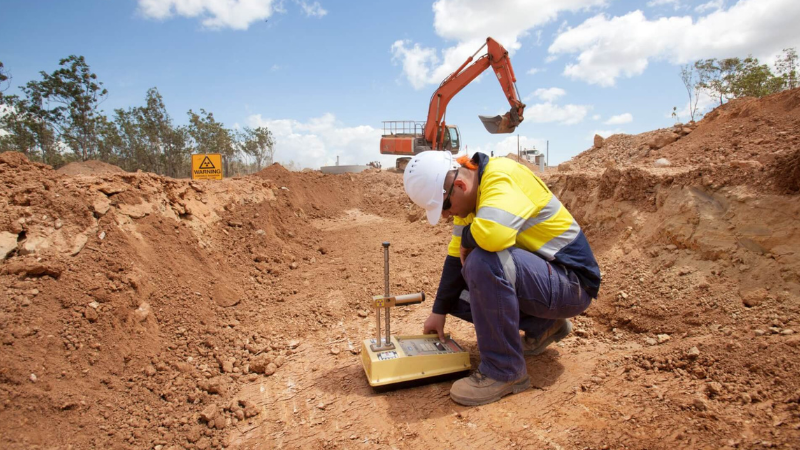An In-depth Overview of the Secret Obligations of Geotechnical Designers in Site Characterization and Ground Enhancement Methods for Design Solutions
Geotechnical engineers are essential to the effective execution of design jobs, tasked with the critical obligations of website characterization and the application of ground renovation strategies. Their work entails a detailed evaluation of subsurface conditions, employing various testing approaches to recognize dirt and rock properties.
Duty of Geotechnical Designers
Geotechnical designers play an essential function in the design and building of framework by examining the habits of soil and rock under the surface - geo tech engineering. Their duties incorporate reviewing subsurface problems to inform style decisions that make sure structural security and safety. By conducting thorough evaluations of soil residential or commercial properties, consisting of shear permeability, compressibility, and toughness, geotechnical engineers give crucial data that influences the selection of proper construction products and techniques
Along with examining soil auto mechanics, geotechnical engineers are entrusted with identifying potential risks such as landslides, sinkholes, and ground negotiations. Their experience helps alleviate risks linked with these geotechnical phenomena, consequently protecting both the setting and public safety and security. They likewise work together closely with other design disciplines, making sure that geotechnical considerations are incorporated into overall task design.
In addition, geotechnical engineers take part in the analysis of existing frameworks, offering suggestions for retrofitting and repair services when required. Their thorough understanding of soil-structure communication is important for the growth of lasting framework solutions. Overall, the function of geotechnical designers is indispensable to the effective understanding of building tasks, guaranteeing they are secure, long lasting, and certified with regulatory standards.

Site Characterization Processes
Effective site characterization procedures are vital for understanding the subsurface conditions that affect project style and execution. Geotechnical designers use a methodical strategy to collect, evaluate, and translate information regarding rock, soil, and groundwater features. This process begins with a comprehensive review of existing literature and historical website data, giving understandings right into previous website problems and possible challenges.

Information evaluation follows fieldwork, where designers make use of geostatistical methods to interpret findings and produce geological versions. Via persistent site characterization, geotechnical designers lay the foundation for successful job execution, minimizing unexpected problems and optimizing resource allotment.
Dirt and Rock Testing Techniques
While recognizing subsurface conditions is essential, the option of suitable dirt and rock screening methods is just as important for accurate analysis and layout. Geotechnical designers utilize a variety of screening techniques to examine the mechanical and physical residential properties of dirt and rock materials.
Lab examinations, such as Atterberg limits, grain size evaluation, and unconfined compressive strength examinations, give necessary data on soil habits under different moisture conditions and packing scenarios. These examinations help figure out dirt category and predict negotiation or shear toughness attributes vital for structure layout.
In-situ screening methods, including Requirement Infiltration Examinations (SPT), Cone Penetration Examinations (CPT), and stress meter examinations, enable engineers to collect data straight from the ground. These techniques provide important understandings right into the dirt's density, consistency, and stratification without the requirement for Related Site extensive sampling.
Rock testing generally includes core tasting and lab analysis to assess properties like uniaxial compressive stamina and rock top quality designation (RQD) With each other, these dirt and rock screening techniques allow geotechnical designers to make enlightened decisions relating to site-specific difficulties, making certain the security and security of design services.
Ground Enhancement Methods
Ground enhancement methods are crucial for boosting the design buildings of dirt, thus increasing its load-bearing ability and minimizing negotiation. These approaches are critical in dealing with obstacles presented by problematic or weak dirts, which can dramatically affect the stability and durability of structures.
Numerous ground improvement techniques are utilized, including compaction, grouting, and dirt stabilization. Compaction involves increasing the density of soil through mechanical methods, which enhances its shear strength and decreases compressibility. Grouting, on the other hand, involves infusing a fluid product right into the ground to load voids and enhance dirt communication. This method is particularly efficient for dealing with loosened sands or fractured rock.
Soil stabilization incorporates an array of methods, from chemical ingredients to mechanical therapies, focused on enhancing the dirt's resistance to disintegration and deformation. Methods such as lime stabilization or cement blending alter the properties of the dirt at a fragment degree, enhancing its general performance.
Value of Geotechnical Assessments
Geotechnical analyses play an important role in the preparation and style of engineering jobs, as they supply crucial information about the subsurface conditions. Comprehending dirt residential or commercial properties, rock developments, groundwater levels, and potential geohazards is crucial for making certain the stability and safety and security of frameworks. These evaluations allow engineers to make educated decisions regarding website choice, design specifications, and construction techniques.
The relevance of geotechnical analyses prolongs past first job phases; they contribute in risk monitoring and cost performance. By identifying potential concerns early, such as soil negotiation, incline instability, or excessive groundwater, designers can create appropriate mitigation approaches, lowering the likelihood of architectural failings and pricey delays. Additionally, these analyses support conformity with regulatory demands and improve the sustainability of design methods.

Verdict
Finally, geotechnical engineers are important to making certain the security and security of design jobs via detailed website characterization and ground enhancement strategies. geo tech engineering. Their systematic strategy to evaluating subsurface problems, combined with their referrals for effective ground adjustment, significantly improves dirt properties and load-bearing capability. The competence of geotechnical designers not only promotes educated task preparation but additionally guarantees conformity with laws and fosters reliable communication amongst stakeholders, inevitably adding to successful design outcomes
Geotechnical engineers play an essential duty in the design and building and construction of facilities by analyzing the behavior of soil and rock below the surface area. By carrying out in-depth evaluations of dirt residential or commercial properties, consisting of shear compressibility, stamina, and leaks in the structure, geotechnical engineers give important information that influences the selection of ideal building and construction products and strategies.
In addition to examining dirt technicians, geotechnical engineers are charged with identifying prospective dangers such as landslides, sinkholes, and ground settlements. Geotechnical engineers employ an organized approach to collect, review, and analyze information relating to soil, rock, and groundwater characteristics. By identifying possible problems early, such as soil settlement, slope instability, or too much groundwater, engineers can devise ideal mitigation approaches, lowering the probability of expensive hold-ups and architectural failures.